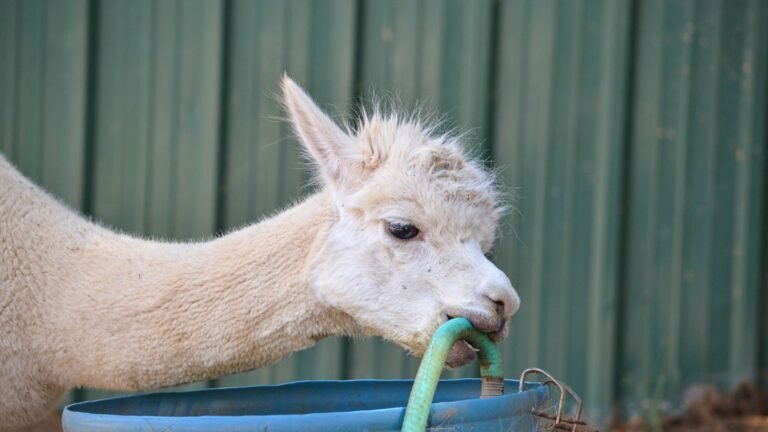Top 3 Tips for a Profitable Alpaca Farm
To run a profitable alpaca farm, focus first on breeding high-quality alpacas with strong genetics and excellent fiber traits. Next, use effective marketing strategies like social media and farm tours to boost your brand and sales. Finally, diversify income by offering services like agisting, workshops, and value-added fiber products. Paying attention to these areas sets a solid foundation for success, and exploring more detailed tips can help you maximize your farm’s potential.
Key Takeaways
- Prioritize breeding high-quality alpacas with diverse genetics to enhance fiber quality and farm profitability.
- Develop multiple income streams including alpaca fiber products, farm tours, and agisting services.
- Utilize effective marketing via social media, online stores, and alpaca shows to boost brand visibility and sales.
- Maintain exceptional herd management with regular health checks, sustainable practices, and detailed record-keeping.
- Stay informed on market trends and consumer preferences to adapt breeding and product offerings accordingly.
Focus on Breeding High-Quality Alpacas

When you focus on breeding high-quality alpacas, you set the foundation for a profitable farm by producing animals with superior fiber traits. Selecting the right breeding stock, including both Huacaya and Suri alpacas, guarantees you cater to diverse market demands with fluffy and silky fleece. Prioritize genetic diversity to avoid inbreeding and improve fiber quality in your cria. Paying close attention to the nutritional needs of breeding females during gestation directly impacts offspring fiber characteristics. Regular fiber assessments through certified labs help you track quality and guide your breeding choices. Staying updated on market trends and breed standards supports smarter herd management decisions, enabling you to maintain an exceptional herd that consistently produces valuable fleece for your farm’s success.
Implement Effective Marketing Strategies
Although breeding high-quality alpacas is essential, you won’t maximize your farm’s profitability without effective marketing strategies. Start by leveraging social media channels like Instagram and TikTok to showcase your alpacas and alpaca products, boosting brand visibility. Create an online store on a user-friendly website to sell directly to customers, expanding your market reach. Attend alpaca shows to network with other farmers and promote your breeding stock and high-quality fleece. Offering educational workshops and farm tours can engage visitors and highlight your farm’s unique qualities. Collaborate with local artisans to develop distinctive alpaca fiber products, tapping into new customer bases. By combining these marketing strategies, you’ll build a strong brand presence and attract loyal buyers, ensuring your alpaca farm thrives.
Diversify Income Streams Through Farm Activities
Since relying solely on alpaca breeding can limit your farm’s income, diversifying through various farm activities is key to boosting profitability. You can offer agisting services, allowing others to board their alpacas on your alpaca farm, creating steady income generation. Organize farm tours and educational workshops to engage visitors, while agritourism initiatives like farm cafés or shops showcasing alpaca products enhance customer experience and revenue generation. Developing value-added products from alpaca fiber—such as yarn, apparel, and home goods—boosts profits beyond raw fleece sales. Additionally, collaborating with local artisans to create exclusive alpaca fiber products expands your market reach and diversifies your offerings. These strategies not only increase income but also strengthen your farm’s brand and community ties.
Frequently Asked Questions
What Is the Best Way to Make Money in Alpaca World?
You might think breeding strategies alone make money, but focusing on fiber quality and product diversification, while managing costs and herd health, guarantees farming sustainability. Combine customer outreach and financial planning to meet market demand effectively.
What Are the Disadvantages of Raising Alpacas?
You’ll face breeding challenges due to long gestation and slow herd growth, plus high care costs, land requirements, and initial investment. Health issues, fiber quality concerns, market fluctuations, regulatory compliance, and time commitment make herd management demanding.
How Many Acres for 3 Alpacas?
You might think three alpacas only need a small space, but acreage requirements vary with grazing habits and herd dynamics. For proper pasture management, fencing needs, shelter options, and land suitability, plan at least one to two acres considering environmental factors and alpaca behavior.
How Much Does It Cost to Start an Alpaca Farm?
You’ll face startup costs covering land requirements, fencing options, and equipment expenses. Don’t forget feed budgets, veterinary care, fiber processing, insurance needs, breeding considerations, plus marketing strategies to guarantee profitability as you launch your alpaca farm.







Our picks
Alpaca & Wool Felted Sole Inserts: Comfy Upgrade?
Best Alpaca Socks for Hiking: Ultimate Comfort and Durability on Trails
Best Alpaca Halter for Comfort and Control